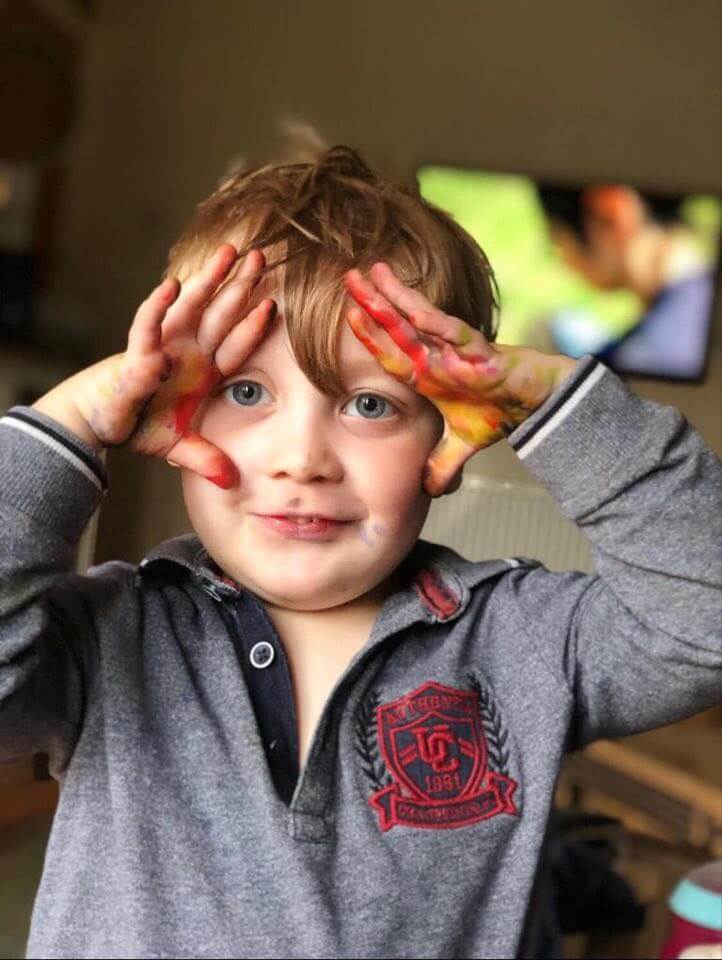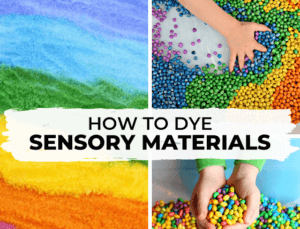20 Ideas on How to Dye Sensory Materials for Messy Play
Dyeing sensory materials is a brilliant way enhance our child’s experience of messy play. Changing the colours of the substances we play with offers excitement, and can increase our child’s visual attention and focus.
We can dye all kinds of household materials to offer our child. Pasta, beans, salt, sand, egg shells, paper and more can be coloured for use in messy play. SEND blogger And Next Comes L has a great guide to dyeing sensory materials, and links to a number of recipes. We have replicated these below.
As ever, when engaging in messy play, be sure to have a bowl of water, a towel and/or wipes to hand so our child can clean their hands as soon as they want or need to.

Feeling different textures is good for stimulating brain development as well as helping our child get used to different sensations. The part of the brain which feels what is happening in the fingers and what happens in the mouth are close to each other in the brain, so if a child gets used to a texture with their hands it is going to make it easier to tolerate this in their mouth. Two handed play also helps brain development, as does crossing the hands to the other side of the body.
Many children with different abilities have trouble with different textures – either feeling too much (hypersensitivity which can lead to tactile defensiveness) or not feeling enough – (leading to sensory seeking behaviours). Messy play is a controlled way to encourage tactile sensitive children to get used to different sensations. This can allow them to tolerate more of their everyday textures.
There is a strong cause and effect with messy play which is motivating for children with less developed attention and great for learning and enjoyment.
Messy play allows for hand strengthening and developing hand-eye coordination. It provides a lot of sensory input and is a fun place for learning and developing gross and fine motor skills.
Preparation is everything! Choose a place in the home or garden for messy play activities – ideally somewhere easy to clear up. You’ll need a surface to play on: tuff spot trays are brilliant for minimising mess, but you can also use trays or containers you already have in the home, or a easy to wipe playmat or table. You’ll also need water, wipes and a towel available nearby for washing hands. Decide what material you are going to play with in advance: some activities take a little while to put together, and you also might want to consider how to make them extra motivating for your child.
Choose a time to play where you are able to join in. Messy play should be an active experience that the child initiates in some way through imitation. If a child is nervous or unsure they might want to watch someone interact with the materials first, so you need to be prepared to get stuck in! Playing together with your child also means you can watch for ways to enhance or extend their play.
Before play, it’s really nice to massage, squeeze or brush your child’s fingers, hands and forearms. This alerts their system and brings awareness to the whole upper limb. A quick finger, hand or wrist stretch can also help them feel and manipulate the messy play substance more effectively.
Ideas for play: if your child is able, or with some hand over hand help, use kitchen utensils to play with the substance – using a wooden spoon to stir, a ladle or spoons to scoop or a potato masher to squish. You can use other things from around the home as tools to further develop motor skills, like paintbrushes, rolling pins, biscuit cutters, cutlery, containers, cups or sponges.
You can also put different objects into the substance for the child to play with. This is motivating and helps build fine motor and visual perception skills. Good options include cars, plastic animals or figurines, or you can tailor it to a specialist interest. Try dropping some items inside the substance for your child to find. Start with bigger objects so they hardly have to touch the messy play mixture; as they get more confident, hide or make the items smaller so your child has to get their hands in the mixture.
Messy play is a brilliant opportunity for imaginative or pretend play. Making food out of play-dough for a dolls tea party, going shopping for items hidden in the messy substance or giving a baby a bath in some coloured yoghurt can offer a novel way to entertain your child.
Mixing different textures can enhance the sensory experience of messy play. For example, adding rice to play-dough offers a very different sensation to the way the items feel alone. This gives more for our child’s system to interpret, and offers a small but safe step away from what is known and familiar.
The blog And Next Comes L has compiled a list of great ideas for dyeing sensory materials.







